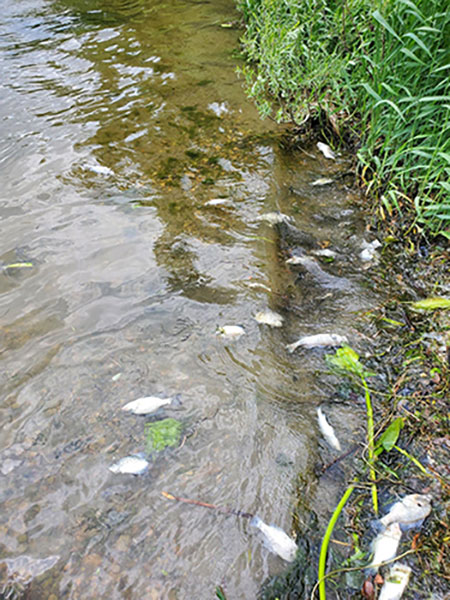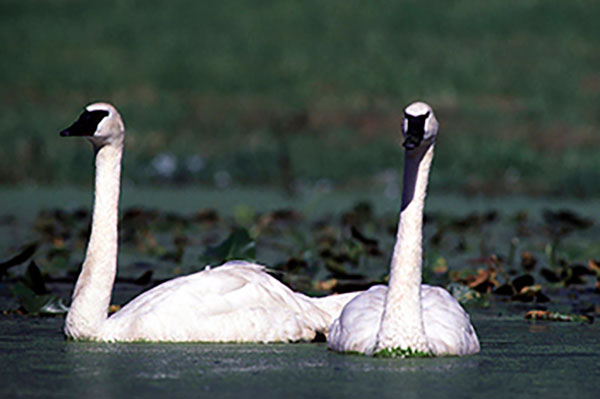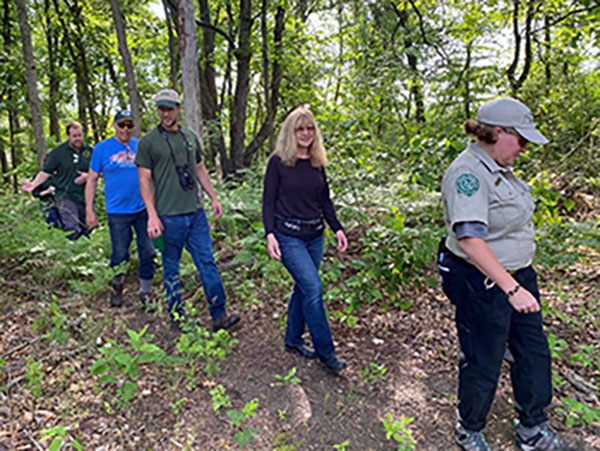- Details
MDNR Report
 Fish Kill
Fish Kill
With increasing temperatures across Michigan, anglers, boaters and lakefront property owners may discover dead fish or other aquatic animals. While such sights can be startling, the Michigan DNR reminds everyone that it is common — summer heat conditions can cause fish and other creatures such as turtles, frogs, toads and crayfish to die.
“The majority of summer fish kills are due to low oxygen in the water, a natural phenomenon associated with weather,” said Jeremiah Blaauw, DNR fisheries biologist. “However, some other factors such as chemical treatments of aquatic plants and algae can increase the risk of a fish kill.”
Environmental conditions strongly affect the stress level of fish; temperature and dissolved oxygen concentrations are key variables. Fish need oxygen just as humans do, but fish absorb dissolved oxygen (oxygen gas that is dissolved in water) directly through their gills into the bloodstream.
- Details
MDNR Report
The Michigan DNR encourages everyone to take advantage of “Three Free” Weekend – Saturday, June 10, and Sunday, June 11.
It's two full days when Michigan residents and out-of-state visitors can grab a fishing rod, ride the off-road trails and visit state parks, boating access sites and other outdoor locations — all free of charge.
“It’s that time of year when everyone gets to enjoy ‘Three Free’ Weekend and take part in some of Michigan’s best outdoor recreation opportunities,” said Acting DNR Director Shannon Lott. "Whether you're an avid outdoors-person or someone just beginning to explore all the options, our 'Three Free' Weekend makes it easy to pursue a new passion, visit a new park or introduce friends and family to an outdoor experience or place you love."
- Details
MDNR Report
 Trumpeter Swans
Trumpeter Swans
The Michigan list of threatened and endangered plants and animals now includes 407 species after completion of its seventh update in nearly 50 years. Experts from universities, the Michigan Natural Features Inventory, other conservation organizations and the Michigan Department of Natural Resources recommended changes to the list based on recent data.
“When people come together to collaborate on conservation, we can recover rare species,” said DNR endangered species specialist Jennifer Kleitch. “For instance, trumpeter swans were just removed from Michigan’s threatened and endangered species list. Their populations have grown as a result of significant conservation efforts by many partners over decades."
Although the trumpeter swan has been removed from Michigan’s list of threatened and endangered species, it is still federally protected under the Migratory Bird Treaty Act.
While 36 species were removed from the list, others still need our help, Kleitch said.
Three bat species – little brown, northern long-eared and tri-colored – have been listed as threatened due to significant population declines in the state resulting from white-nose syndrome. Rusty-patched bumblebees and American bumblebees were added to the endangered species list because, like many pollinator species, their populations are seeing large declines.
In all, 58 species were added to the list as either threatened or endangered.
- Details
By DON POPPE and RACHEL LEIGHTNER, Michigan DNR
 Gourdneck State Game Area
Gourdneck State Game Area
Surrounded by family homes, thriving businesses and city traffic, Gourdneck State Game Area is the first designated urban state game area of its kind.
Here hunters and community members have an opportunity to connect with nature via a short drive or walk.
The Michigan Department of Natural Resources Wildlife Division oversees more than 340,000 acres of public lands in southern Michigan.
This system of lands known as state game and wildlife areas includes more than 100 locations specifically managed for wildlife habitat and hunting opportunity that are open to public use for wildlife-based recreation.
Gourdneck State Game Area is nestled in the bustling city of Portage in Kalamazoo County. The area is divided into four distinct sections totaling over 2,293 acres. Almost entirely within the Portage city limits, Gourdneck is still a popular destination for hunters, and a hub for diverse wildlife populations and habitats.
- Details
By SIERRA WILLIAMS, Michigan DNR
 Jim Dexter
Jim Dexter
It’s the age-old question many children are asked, “What do you want to be when you grow up?” Well, around the age of 10, Jim Dexter knew exactly what field he wanted to work in, but he never imagined or planned that it would lead him to be the Michigan Department of Natural Resources Fisheries Division Chief.
Dexter caught his first fish, which was a northern pike, at the age of 3 with his grandfather. Not only was this the start of him being hooked on the thrill of catching fish, but his appreciation for the world of fisheries grew with each cast and catch.
Dexter credits his grandfather for his love of fishing, as he was the one who taught him all the tips and tricks on how to fish.
Throughout his childhood, Dexter spent a lot of time outdoors. He and his friends would share fishing tips, trade tackle and catch bluegill, bass and crappie at a small local lake. If they weren’t on the water, then then were likely found at the local Kmart to pick up the latest lure that came out.
His love for the outdoors carried on to his junior and high school years as he volunteered nearly every weekend at the Bloomfield Hills E.L. Johnson Nature Center.
He helped manage the pond on the grounds and built a dock for visitors to fish from. Here is where he met his first mentor, who he spent time with discussing careers and the outdoors. With a career path in mind, Dexter graduated high school and prepared for college.


